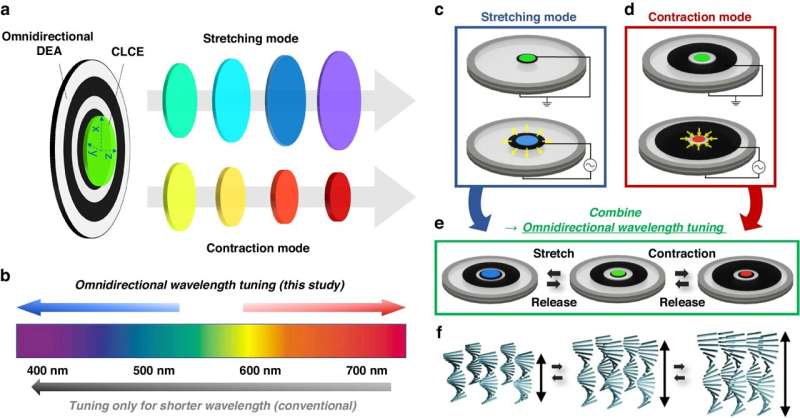This article has been reviewed according to Science X's editorial process and policies. Editors have highlighted the following attributes while ensuring the content's credibility:
fact-checked
peer-reviewed publication
trusted source
proofread
Omnidirectional color wavelength tuning method unlocks new possibilities for smart photonics

In the rapidly evolving field of photonics, an advancement has emerged from Korea, redefining the possibilities of structural color manipulation. Scientists have developed a pioneering technology capable of omnidirectional wavelength tuning, which promises to revolutionize a myriad of tunable photonic applications.
Structural colors, derived from the interaction of light with nano-periodic structures, have long captivated researchers due to their vibrant hues and potential for tunability. Traditional methods, however, have critical technical limitations, primarily allowing for wavelength tuning in only one direction—towards only shorter wavelengths (blue-shifting) according to the triggering method for altering the periodic photonic structure. This constraint has been a significant bottleneck, stifling innovation in the realm of more advanced and higher functional photonic devices.
In a new paper published in Light: Science & Applications, a team of scientists, led by Professor Su Seok Choi from Pohang University of Science and Technology (POSTECH), Korea and co-workers (Seungmin Nam, Wontae Jung, Jun Hyuk Shin) have developed an omnidirectional color wavelength tuning method for structural colors of chiral photonic elastomers.
The innovation is a method for achieving omnidirectional wavelength control, enabling tuning towards both longer and shorter wavelengths with remarkable precision and broadband tuning range. At the heart of this technology lies the strategic manipulation of stretchable and reconfigurable chiral liquid crystal elastomers (CLCEs) in conjunction with dielectric elastomer actuators (DEAs).
By expertly controlling the areal expanding and contractive strain of these materials, the researchers have unlocked simultaneous and multidirectional structural color tuning with high flexibility in wavelength control.
This unprecedented level of control opens up new horizons for photonic applications, ranging from tunable camouflage and optical sensing to the development of electronic skin. The ability to fine-tune wavelengths on demand and across a broad spectrum not only enhances the degree of freedom in photonic system design but also heralds a new era of high-functional, versatile photonic devices.
Traditional reconfigurable photonic devices have relied heavily on unidirectional wavelength tuning, which, while useful, limited the scope of applications. With the advent of omnidirectional tuning method, devices can now dynamically adjust to a wider range of optical requirements, making them more adaptable and effective in real-world applications.
Moreover, this technology leverages the inherent advantages of CLCEs, such as their high optical quality, ease of fabrication, and scalability while overcoming previous limitations related to wavelength tuning. The novel approach of employing multi-modal electro-active DEAs deformation enables pitch-expanding and also pitch-shortening deformation of the CLCE and structural color shift towards longer and shorter wavelengths.
This innovation not only signifies a significant advance in photonic technology but also underscores the potential of interdisciplinary research in overcoming longstanding challenges.
More information: Seungmin Nam et al, Omnidirectional color wavelength tuning of stretchable chiral liquid crystal elastomers, Light: Science & Applications (2024). DOI: 10.1038/s41377-024-01470-w
Journal information: Light: Science & Applications
Provided by Chinese Academy of Sciences




















